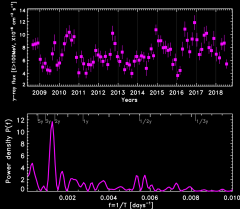For release: Oct. 17, 2018
Prof. Lynn Cominsky, Press Officer
Eighth International Fermi Symposium
lynnc@universe.sonoma.edu
707-695-7140
Blazar's Brightness Cycle Confirmed by NASA's Fermi Mission
 A two-year cycle in the gamma-ray brightness of a blazar, a galaxy powered by a supermassive black hole, has been confirmed by 10 years of observations from NASA's Fermi Gamma-ray Space Telescope. The findings were announced today at the Eighth International Fermi Symposium meeting this week in Baltimore.
A two-year cycle in the gamma-ray brightness of a blazar, a galaxy powered by a supermassive black hole, has been confirmed by 10 years of observations from NASA's Fermi Gamma-ray Space Telescope. The findings were announced today at the Eighth International Fermi Symposium meeting this week in Baltimore.
"This is the first time that a gamma-ray period has been confirmed in an active galaxy," said Stefano Ciprini, a researcher at the INFN Tor Vergata division of the Italian Space Agency's Space Science Data Center in Rome. "The gamma-ray period is also seen in other wavebands, including visible light, and additional X-ray and radio data hint at similar brightness peaks."
Some of the matter falling into the blazar, named PG 1553+113, forms a jet of particles that radiates gamma rays, the highest-energy form of light, almost directly toward Earth.
"This result has been achieved after 10 years of continuous monitoring by Fermi's Large Area Telescope (LAT)", said Sara Cutini, a researcher at the Italian Institute for Nuclear Physics (INFN) in Perugia. "We first saw a hint of a periodic modulation in 2014, when we produced detailed analyses of LAT data. Now we can say with certainty that this long-term behavior is real." (See earlier story at: https://www.nasa.gov/feature/goddard/nasas-fermi-mission-finds-hints-of-gamma-ray-cycle-in-an-active-galaxy)
 A pair of supermassive black holes in the heart of the blazar is the most tantalizing possibility. In this scenario, one of the supermassive black holes would be emitting the gamma rays in a jet, and the direction of this jet "wobbles" due to interactions with its companion black hole. This would make PG 1553+113 a prime target for a future space-based gravitational wave detector, such as the European Space Agency's Laser Interferometer Space Antenna (LISA), set for launch in the 2030s, or by the Square Kilometre Array (SKA), a giant radio telescope, which is under construction in South Africa and Australia.
A pair of supermassive black holes in the heart of the blazar is the most tantalizing possibility. In this scenario, one of the supermassive black holes would be emitting the gamma rays in a jet, and the direction of this jet "wobbles" due to interactions with its companion black hole. This would make PG 1553+113 a prime target for a future space-based gravitational wave detector, such as the European Space Agency's Laser Interferometer Space Antenna (LISA), set for launch in the 2030s, or by the Square Kilometre Array (SKA), a giant radio telescope, which is under construction in South Africa and Australia.
The scientists caution that other interpretations can explain the cyclic emission. For example, there could be periodic instabilities in a disk of matter swirling around a single supermassive black hole, or there could be general relativistic effects that cause the gamma-ray-emitting jet to precess.
"The periodic variations in visible light, gathered over 12 years by optical telescopes on Earth and in space, are similar and well correlated with what we see in high-energy gamma-rays from Fermi's Large Area Telescope. It is a totally new discovery for high-energy gamma-ray blazars and active galaxies," said Stefan Larsson, a researcher at the Royal Institute of Technology in Stockholm, Sweden.
 A paper detailing the comprehensive analysis is being prepared.
A paper detailing the comprehensive analysis is being prepared.
NASA's Fermi Gamma-ray Space Telescope is an astrophysics and particle physics partnership, developed in collaboration with the U.S. Department of Energy and with important contributions from academic institutions and partners in France, Germany, Italy, Japan, Sweden and the United States.
For more about NASA's Fermi mission, visit:


